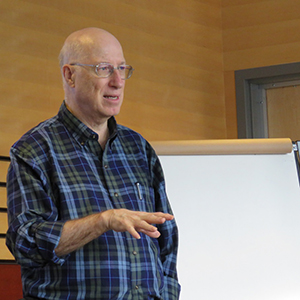Keith Barker’s presentation on the Myers-Briggs Type Indicator (MBTI) on Saturday, November 19, provided chapter members with a personal exploration of how the MBTI works, and how it can be used to resolve conflicts in the workplace.
The MBTI is a self-report questionnaire designed to make Jung’s theory of psychological types understandable and useful in everyday life. Keith explained Jung’s theory, in which people are involved in one of two mental activities: perceiving (taking in information) or judging (organizing that information and forming conclusions). And within these two mental activities, Jung identified two opposite ways of perceiving – sensing and intuition; and two opposite ways of judging – thinking and feeling.
In addition to these four basic mental processes, Jung noted that people focus their energy on either the internal world or the external world: introversion or extroversion.
Keith explained how sensing, intuition, thinking, and feeling are generally directed either inwards (introversion) or outwards (extroversion). We all use our minds in different ways, acting on our tendencies, and developing our MBTI types from our innate preferences.
With so many variations in how people perceive information, it can be difficult to accept those who are think differently. This can often cause workplace misunderstandings and friction in personal relationships. Keith addressed the importance of seeing the strengths and weaknesses of each personality type and coming from a place of understanding.
For example, the T-F (thinking-feeling) personality type is logical, objective, and compassionate. When viewed through the opposite personality type, the T-F type can instead be seen as cold, critical, and even paranoid. Through being aware of our own perceptions, both positive and negative, we are able to control the outcome of our thoughts towards others.
The presentation was engaging for a wide range of audiences, from those already versed in personality type dynamics to those learning for the first time. Keith provided many effective exercises for the audience to grasp various concepts.
For example, he explained dominant functions by asking the audience to write their name with their non-dominant hand. The audience quickly realized how their dominant hand had taken over the skill of writing while their non-dominant hand stopped progressing at a young age. The same theory can be applied to baseball where the dominant hand throws the ball, while the non-dominant hand learns to catch.
The STC Canada West Coast chapter thanks Keith for a personal and involved presentation peppered with humor. At the end of the presentation, he had many curious audience members making their way to his table to continue the discussion of personality types and their effects on human interaction.

